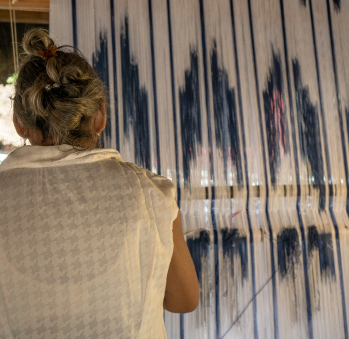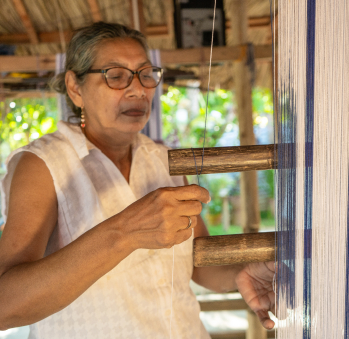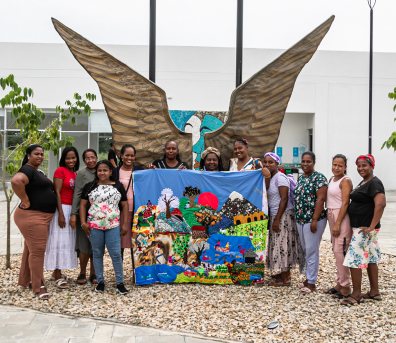Olivia del Socorro Carmona de Castellar
Workshop: Taller escuela Olivia Carmona museo vivo
Craft: Tejeduría
Trail: Bolívar Route
Location: San Jacinto, Bolívar
Olivia thinks of the times gone by. She ponders times much earlier than those of her grandmother, Francia Helena, her mother, Cristina del Socorro, or her aunt, Rosalía. All of them taught her the art of hammock weaving. She thinks of the portion of the indigenous Zenú people who settled in these lands of San Jacinto to grow cotton. They traded with it and made blankets with which their chief —a woman— could cover herself. She contemplates how, for years, the land’s settlers, who were mostly farmers, used hammocks to transport the sick out of both the rainforest and the most remote farms.
She has acquired all of this knowledge exclusively by listening to her people, since hers is an oral tradition dedicated to keeping its legacy and history alive. This was the only way of getting to know this community’s heritage until researcher Abel Viana set himself to the task of compiling San Jacinto’s customs, folklore, and its crafting tradition. When she saw her history compiled in this massive text, she was moved.
Olivia has witnessed the passage of time. She remembers how her parents and grandparents wove to earn their daily livelihoods, without having much knowledge about costs or profits. Today, this trade is crucial for the economy of San Jacinto and, as such, it must be protected. The latter is achieved by continuing to make the most beautiful hammocks possible: mastering their crafting processes, preserving the quality of their raw material, and keeping an eye on their commercialization.
She knows for certain that one of the ways in which the town’s source of income can be protected is teaching. Hence, she does it, and does it very well. “We have to leave this life empty-handed: we need to leave everything we have behind.” She says these words with the uttermost confidence that can only come from a lifetime of experience. This is why her workshop is full of apprentices who, through their youthful and innovative ideas, fill her with pride and energy.
She tells them stories while she weaves. Some of them are happy, others, not so much. All of them, however, somehow express what life is like. She shares, for instance, how her grandmother used to plant tobacco, and how, after the harvest, she would weave so she could gather enough money to feed her children. Another story she recounts is about how her mother. She was just starting her new household out and wove a small band every night to buy milk for her firstborn son. She was a self-made woman, like many other in her line of work.
Olivia smiles when she remembers that, when she was underage, she had to get a sponsor to be allowed to work. Her desire to help her family drove her to gather the yarns they needed to weave and progress. They had so much work at home that she could only graduate high school years after she was meant to. She went through the final stages of school so she could study Popular Arts at university. She is happy because the harsh times —during which cars rushed past the town because they were too scared to stop by— are a thing of the past. Today, the town is a must-see and a pleasant place to stop for anybody passing through. And it is very colorful, of course.
Craft




Artisans along the way
Artisans along the way
No puede copiar contenido de esta página










































































